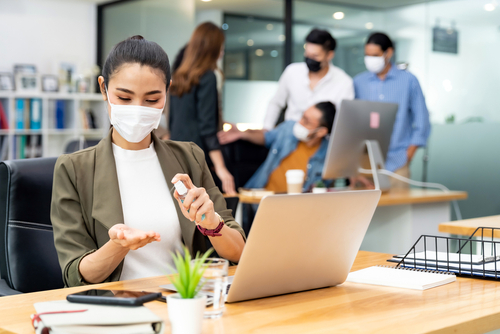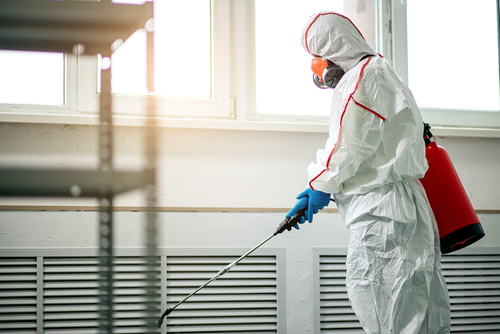
The Ultimate Guide to Home Sanitization in the Post-Pandemic Era
April 1, 2024
Home Disinfection: Tips and Tricks for Homeowners
April 19, 2024Preventing Infections in Office Through Disinfection Service

Preventing Infections in Office Through Disinfection Service
Preventing Infections in Office Through Disinfection Service. In the wake of global health concerns, the cleanliness of our work environments has taken center stage.
Offices, bustling hubs of collaboration and productivity, are also potential hotspots for the transmission of infectious diseases.
The importance of maintaining a sanitized office space cannot be overstated—it’s essential for the health of employees and the seamless operation of businesses.
This necessity brings professional disinfection services to the forefront of preventive measures, offering specialized solutions to keep workspaces clean and infection-free.
Understanding the Need for Office Disinfection
The Pathways of Infection in Offices
Offices are communal spaces where employees interact closely, share facilities, and use common equipment. This environment, unfortunately, creates ample opportunities for pathogens to spread.
High-touch surfaces like door handles, shared technology like printers, and communal areas such as break rooms and conference spaces are all vectors for the transmission of germs.
Without regular and thorough disinfection, these areas can become reservoirs of infection, contributing to increased absenteeism and decreased productivity.
The Impact of Disinfection on Workplace Health
The strategic implementation of regular disinfection practices significantly mitigates the risk of disease spread, fostering a healthier work environment.
This proactive approach to workplace hygiene can reduce absenteeism due to illness, thereby maintaining or even enhancing productivity.
The psychological benefits are equally important; knowing that their workspace is regularly disinfected can boost employees’ morale and create a sense of security, contributing to a more positive and focused work atmosphere.
Identifying High-Risk Areas in the Office

Hotspots for Germs
Identifying and prioritizing areas in the office that are more prone to harboring pathogens is crucial for effective disinfection.
Restrooms, break rooms, and kitchens, where employees gather for meals or breaks, require special attention.
Meeting rooms and communal workspaces, including open-plan areas, are also high-risk zones due to the frequency of shared touchpoints.
Prioritizing High-Touch Surfaces
Effective disinfection strategies focus on high-touch surfaces to prevent the spread of infection. This includes light switches, elevator buttons, door handles, and shared office equipment.
Regular sanitization of these surfaces is essential in breaking the chain of infection, forming the first line of defense against the spread of pathogens in office settings.
Selecting a Professional Disinfection Service
Choosing the right professional disinfection service is pivotal. Key considerations should include the service provider’s expertise, particularly their experience in disinfecting office environments, and the effectiveness and safety of the disinfectants used.
Opt for services that employ EPA-approved disinfectants proven to eliminate a wide range of pathogens while ensuring they are safe for use in populated environments.
Given the increasing concern for environmental sustainability and employee health, selecting services that use eco-friendly and non-toxic disinfectants offers additional benefits.
These products are effective against pathogens but pose less risk to human health and the environment, aligning with corporate sustainability goals and ensuring a safe workplace for employees with allergies or sensitivities.
Planning and Executing an Effective Disinfection Strategy

Before the Service
Preparation is key to maximizing the effectiveness of professional disinfection services. Inform employees ahead of time to secure personal items and sensitive equipment.
Developing a disinfection schedule that minimizes disruption ensures that disinfection efforts are thorough and comprehensive, covering all identified high-risk areas without significantly impacting workflow.
During the Service
Understanding what to expect during the disinfection process helps in planning and managing office activities.
Professional services typically require access to all areas of the office and may use various methods, from manual wiping of surfaces to fogging, depending on the area and level of disinfection required.
Ensuring staff are informed of safety measures and any required actions on their part can facilitate a smooth and efficient disinfection process.
After the Service
Post-disinfection, it’s essential to follow guidelines for re-entering and using the office space, adhering to any safety advice provided by the disinfection service.
Implementing regular cleaning protocols that complement professional disinfection efforts helps maintain a high standard of hygiene, reducing the risk of pathogen buildup between service intervals.
Ongoing Measures to Prevent Infection Spread
Encouraging employees to adopt daily cleaning and disinfection routines for their workspaces and common areas can significantly enhance the overall hygiene of the office.
Simple practices, such as wiping down desks, keyboards, and phones with disinfectant wipes, contribute to maintaining a clean environment.
Continuous education on the importance of personal hygiene and cleanliness in the workspace is vital.
Regular reminders about hand hygiene, respiratory etiquette, and the correct use of personal protective equipment (PPE) can reinforce good practices and ensure compliance with workplace hygiene protocols.
Integrating Disinfection Services into Business Continuity Planning

Incorporating regular professional disinfection services into the broader framework of business continuity planning equips organizations to better handle future health crises.
Regular disinfection is not only a response to current health concerns but a proactive measure that prepares offices for potential future outbreaks, ensuring business operations can continue with minimal disruption.
Additional Considerations
Overlooked Areas in Disinfection
Ventilation systems and electronic devices, often overlooked in regular cleaning routines, require attention in a comprehensive disinfection plan.
Ensuring proper ventilation can reduce the concentration of airborne pathogens, while disinfecting electronic devices, particularly those that are shared, further reduces the risk of surface transmission.
Impact of Office Layout on Infection Risk
The design and layout of office spaces can significantly influence the effectiveness of disinfection efforts.
Open-plan offices may require different strategies compared to traditional cubicle setups.
Reevaluating office layouts, including the placement of desks and communal areas, can enhance the overall effectiveness of disinfection protocols, contributing to a safer work environment.
Preventing Infections in Office Through Disinfection Service – Conclusion

The implementation of professional disinfection services is a critical component of maintaining a healthy office environment.
By understanding the need for regular disinfection, identifying high-risk areas, selecting the right service provider, and planning effectively, businesses can significantly reduce the risk of infection spread.
Integrating these practices into regular operations and business continuity planning ensures that offices remain safe, productive spaces for all employees, underscoring the importance of a proactive approach to office hygiene.
Are you seeking professional and reliable disinfection services in Singapore? Contact us today!




